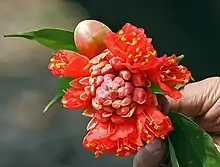Brownea coccinea
Brownea coccinea is a species of small native evergreen tree with compound leaves and clusters of bright scarlet flowers in the subfamily Caesalpinioideae of the family Fabaceae.[3] Common names include scarlet flame bean, mountain rose, rose of Venezuela and cooper hoop.[2][4] The species is native to Colombia, Ecuador and Venezuela.[1]
| Brownea coccinea | |
|---|---|
 | |
| Flower & its bud in Kolkata, West Bengal, India. | |
| Scientific classification | |
| Kingdom: | Plantae |
| Clade: | Tracheophytes |
| Clade: | Angiosperms |
| Clade: | Eudicots |
| Clade: | Rosids |
| Order: | Fabales |
| Family: | Fabaceae |
| Genus: | Brownea |
| Species: | B. coccinea |
| Binomial name | |
| Brownea coccinea | |
| Synonyms | |
Brownea coccinea, is a small to mid-sized tree with slender branches and a rounded crown and reaches a height of about 12 ft .[5] Brownea coccinea trees have compound leaves which are 10–35 cm. long, containing 4-10 leaflets. Leaflets are oblong or elliptic, pointed at the apex and 4–23 cm. long and 1.5-6.5 cm. wide and smooth. Flowers are tubular with orange-scarlet calyx and petals and 10-12 protruding stamens in heads 7–9 cm. wide surrounded by downy red bracts and in clusters of 2-3 on branches are trunks. Seed pods are brown and 12–24 cm. long, 4 cm. wide and contain 4-10 flat seeds.[6]
Medicinal Uses
.jpg.webp)
In Trinidad, infusions of the flowers are consumed as a remedy for colds and coughs. The fresh bark of the tree is used as an anti-hemorrhagic and applied to wounds. Other uses for the plant are as an emmenagogue to stimulate blood flow to the pelvic area and uterus in order to stimulate menstruation, and as an abortifacient.[6] It is commonly used to treat gynecological disorders such as dysmennorrhea and menhorrhagia.[7]
References
- Botanic Gardens Conservation International (BGCI) & IUCN SSC Global Tree Specialist Group (2019). "Brownea coccinea". IUCN Red List of Threatened Species. 2019: e.T144278214A149028991. Retrieved 10 June 2020.
- "Brownea coccinea". Germplasm Resources Information Network (GRIN). Agricultural Research Service (ARS), United States Department of Agriculture (USDA). Retrieved 2007-08-25.
- Winer, Lisa (2009). Dictionary of the English/Creole of Trinidad & Tobago : on historical principles. Winer, Lise., Canadian Electronic Library. Montreal [Que.]: McGill-Queen's University Press. ISBN 978-0-7735-7607-0. OCLC 759157066.
- Roskov, Y.R.; F.A. Bisby; J.L. Zarucchi; B.D. Schrire; R.J. White (November 2005). "ILDIS World Database of Legumes: draft checklist, version 10". Archived from the original on 2007-05-09. Retrieved 2007-08-25.
- United States Herbarium (1914–1917). "Brownea coccinea Jacq". Contributions from the United States National Herbarium. 18: 153 – via Biodiversity Heritage Library.
- Morton, Julia Frances (1981). Atlas of medicinal plants of Middle America : Bahamas to Yucatan. Springfield, Ill.: C.C. Thomas. ISBN 9780398089696. OCLC 849937602.
- Sarwar, Abeer; Huq, Tamanna Binte; Malik, Tasnia; Kumar Das, Biplab (2015). "Antioxidant and analgesic activities of ethanol leaf extract of Brownea coccniea" (PDF). Advancement in Medicinal Plant Research. 3 (2): 69–72 – via NetJournals.org.
